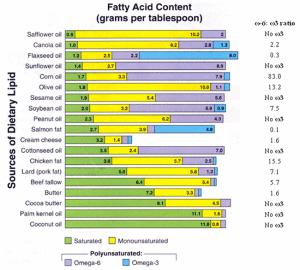I began this article after reading a decent write up describing the problems with Canola Oil, by Swanson Vitamins The (Not-So) Hidden Dangers of Canola Oil, it’s worth a read, especially if you’re new to the subject. But I thought I would add some more science to the issue.

First, when you see people use the terms “polyunsaturated fatty acids”, that is one of three major types of fats in the diet, usually found in “vegetable oils” (I hate that term, they aren’t getting this oil from broccoli), mostly derived from seeds such as corn, rapeseed, sunflowers. It is often abbreviated as “PUFA”. Of the “fatty acids” under the PUFA umbrella the two most commonly known are Omega 3 and Omega 6. The chart above shows the ratios of Saturated, Monounsaturated, and Polyunsaturated fats in various oils and fats we find at the grocery store (shown in the bar chart). On the right side it shows the ratio of Omega 6:Omega 3 in each.
Don’t be fooled by the bottle, Canola oil is not heart healthy! They often tout the benefits of its high Omega 6 content, totally overlooking the science that too much Omega 6 is very bad for us. Also overlooking the fact that westerners already consume about 10-20 times, on average, more Omega 6 than we should! We’re basically overdosing on Omega 6.
“The study provides evidence that bacteria from the human colon can hydrogenate C18 essential polyunsaturated fatty acids” — PubMed #10530040
“dietary PUFA promote the growth of Gram negative bacteria and thus contribute to the pathogenesis of the disease…when tissues are flooded with n-6 PUFA…Gram negative bacteria can preponderate, activate complement and thus macrophages via their lipopolysaccharide coat…A second means whereby n-6 PUFA may promote the development of infection is through changes in immune function…The oil microdroplets apparently are taken up by phagocytic cells, which become ‘clogged’ and are no longer capable of phagocytosis…When PUFA are delivered as food via the oral route, they appear in the plasma and in membranes of circulating lymphoid cells quite rapidly…The presence of relatively large amounts of these fatty acids can be expected to alter immunocyte function in at least two ways: via an increase in membrane ‘fluidity’ and via the production of immunologically-active eicosanoids… Clinical observations, coupled with ongoing exploration of the mechanisms of PUFA-induced enhancement of growth of Gram negative bacteria, should provide a means of judging whether a high n-6 PUFA intake would be detrimental in conditions which might lead to sepsis.” — Proceedings of the Nutrition Society (1986),4 5, 327-331
“levels of omega 6 are so high in our bodies that any more unsaturated fatty acid — even omega 3, despite its health benefits — will actually contribute to the negative effects omega 6 PUFA have on the heart and gut…recent research has linked excessive levels of omega-6 to colitis, insulin resistance, diabetes and obesity, he said. And people’s attempts to “balance” omega-6 levels with omega-3 supplements may be damaging their health…There is no magic pill that fixes a bad diet…A diet that includes foods rich in saturated fats, such as cheese and butter, and healthy unsaturated fats, such as those in olive oil and nuts, will promote a more natural balance of fats, not unlike the Mediterranean diet” — Sanjoy Ghosh published in the British Journal of Nutrition
“Excessive amounts of omega-6 polyunsaturated fatty acids (PUFA) and a very high omega-6/omega-3 ratio, as is found in today’s Western diets, promote the pathogenesis of many diseases, including cardiovascular disease, cancer, and inflammatory and autoimmune diseases, whereas increased levels of omega-3 PUFA (a low omega-6/omega-3 ratio) exert suppressive effects. In the secondary prevention of cardiovascular disease, a ratio of 4/1 was associated with a 70% decrease in total mortality. A ratio of 2.5/1 reduced rectal cell proliferation in patients with colorectal cancer, whereas a ratio of 4/1 with the same amount of omega-3 PUFA had no effect. The lower omega-6/omega-3 ratio in women with breast cancer was associated with decreased risk. A ratio of 2-3/1 suppressed inflammation in patients with rheumatoid arthritis, and a ratio of 5/1 had a beneficial effect on patients with asthma, whereas a ratio of 10/1 had adverse consequences. These studies indicate that the optimal ratio may vary with the disease under consideration. This is consistent with the fact that chronic diseases are multigenic and multifactorial. Therefore, it is quite possible that the therapeutic dose of omega-3 fatty acids will depend on the degree of severity of disease resulting from the genetic predisposition. A lower ratio of omega-6/omega-3 fatty acids is more desirable in reducing the risk of many of the chronic diseases of high prevalence in Western societies, as well as in the developing countries, that are being exported to the rest of the world.” — PubMed #12442909
The goal should be to greatly reduce the amount of Omega 6’s in the diet, not to simply add more Omega 3’s. Omega 3’s are healthy, but not if you are already consuming a lot of Omega 6 (canola oil, corn oil, vegetable oil). All polyunsaturated fatty acid (PUFA) oils go rancid very quickly, they also break down when heated (e.g. used to cook with), in fact they can actually break down and go rancid in human cells. Vegetable oils can be replaced by high saturated fats such as; coconut oil, palm oil, ghee, butter, non-hydrogenated lard, and beef tallow, as well as by monounsaturated oils such as olive and avocado oil. In our house it is mostly coconut oil and olive oil for cooking (depending on the dish), butter is used liberally on vegetables and squashes.
Humans do need some Omega 6’s and Omega 3’s in the diet, but it is pretty well known that we need to improve our (collective) horrible ratio of the two fats. Currently in the U.S. the average ratio is currently over 20:1 (Omega 6 to Omega 3), this ratio should be around 3:1! Paleo man probably had a ratio closer to 1:1. However, we shouldn’t do this simply by increasing Omega 3 fats, we must lower the Omega 6. This means consuming no fried foods cooked in vegetable oils! Avoid pork and chicken, which are very high in Omega 6. If you do eat them try to get free range and consume the leaner cuts, and do not eat the chicken skin, it is very high in Omega 6. This is not to insinuate going on a low fat diet! Fats are good, just avoid fats high in Omega 6.
I think it’s time for for my tablespoon of extra virgin coconut oil.
All images posted by John Herron are either "Copyrighted John Herron", or are copyrighted by someone else and are used under license. So please don’t use them elsewhere, you’ll get in trouble.

 Phage Complete comes with a full 30 day money back guarantee, for U.S. purchases this includes the original shipping charges to you!
Phage Complete comes with a full 30 day money back guarantee, for U.S. purchases this includes the original shipping charges to you!